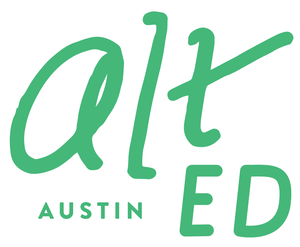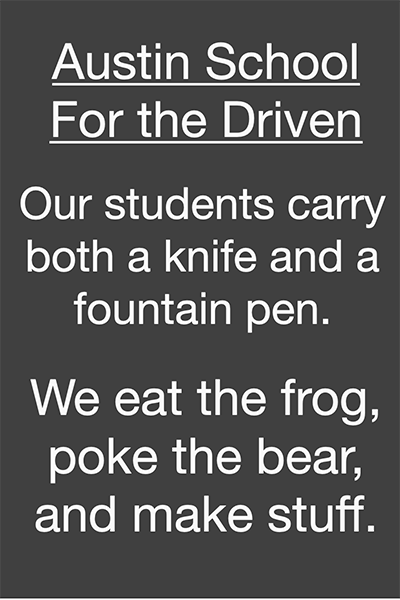Cunningham Elementary: A Changemaker School in the heart of South Austin
/The PEAS garden shed at Cunningham Elementary School. Mural painted by artist JJ Muzacz. (Photo by Dawn Johnson.)
Although alternative private schools are the main focus at Alt Ed Austin, we often work with families to choose the best public school options for their kids. Cunningham Elementary in South Austin is one of the most creative and visionary of these, as you’ll learn in this heartfelt guest post from Dawn Johnson, an artist, teacher, community activist, and Cunningham PTA member. You can enjoy more of Dawn’s work by visiting her studio online.
On a recent sunny morning in south Austin, PEAS Community Farm and Urban Orchard is abuzz with activity. Children are running through the garden rows. Parents, caregivers, friends, and community organizers are weeding and planting and digging in the dirt. Crops are thriving, recently planted fruit trees are soaking up the sun, and conversations about the next set of seedlings are circling through the group. A local colony of bright green monk parakeets flies overhead, landing in the oak trees and calling to one another in parrot-song.
PEAS Farm is located at Mary Ellen Cunningham Elementary, a beautiful little gem of a school nestled in the heart of 78745. Cunningham is an AISD elementary school, and Principal Amy Lloyd, along with her active and innovative teachers and staff, are turning the old ideas of public education upside down.
Principal Lloyd emphasizes “Social Emotional Learning as the foundation in education, with peace paths, and peace areas in all classrooms, outdoor gardens, and throughout the playground! Empathy is a focus, and Cunningham will go deeper with that topic every year. Students are respected as 'Changemakers' for the future and are developing their lens for seeing changemakers in our society.”
Cunningham Elementary is a designated Ashoka Changemaker School, one of a select number of schools throughout the United States. Changemaker Schools are chosen based on “a global community of leading elementary, middle and high schools that prioritize empathy, teamwork, leadership, problem-solving and changemaking as student outcomes. These schools are leading a transformation in education that supports children as changemakers.”
Cunningham also worked closely with Compassionate Austin and local artist Calder Kamin to create an on-site Compassion Tree Sculpture. Cunningham’s Art Specialist engaged students in learning compassion through daily experiences, and the Compassion Tree grew with their collaboration.
A scene from Science Fair Week at Cunningham Elementary: compassion in action. (Photo by Dawn Johnson.)
Cunningham develops children’s spirit of entrepreneurship through its school-wide MicroSociety, which feeds into further entrepreneurship programs at Covington Middle School and Crockett High School. In addition to student-led meetings and entrepreneurial and government-themed groups throughout the year, there is a monthly Market Day when the students put their business skills to practical use.
The school is dedicated to social justice curriculum development, including diverse books and literacy in all classroom libraries. Principal Lloyd explains: “At Cunningham, there is one dual-language classroom at each grade level, with a school-wide model of inclusion that honors bi-literacy and multicultural understanding.” Teachers present academics through a fresh and engaging platform, giving the children tools to be successful in today’s increasingly technological world. Science Fair is an exciting time of year, as students hypothesize, experiment, and demonstrate their ideas, hoping to head to citywide competitions.
Cunningham students learning entrepreneurial skills during MicroSociety Market Day. (Photo by Dawn Johnson.)
Principal Lloyd loves to talk about Cunningham’s Creative Learning Initiative, which “infuses an arts-rich curriculum into all classrooms, enhancing and building and honoring creativity and innovation.” Ballet Folklórico dance performances with students under the tutelage of Breathing Danza bring life, stories, costumes, and a magical atmosphere to the stage. The sensational art, music, and physical education departments are an integral part of the students’ day. And infused in Cunningham’s bright cultural and artistic atmosphere, Friday school assemblies are alive with dancing, drumming, singing, and laughter. The old rigid school assemblies are nowhere to be found here; instead, the children and teachers come together each week in a spirit of music and celebration.
Cunningham Elementary thrives with a healthy living lifestyle and works closely with Go Austin, Vamos Austin (GAVA) to implement vibrant and healthy programs throughout the seasons. Brighter Bites provides abundant bags of fruits and veggies for six weeks in each fall and spring semester for every family. The campus is also host to an organic farm stand throughout the school year, working together with GAVA, The Sustainable Food Center, and Farmshare Austin. And PEAS Farm enables educators and volunteers to teach environmental sustainability to our future stewards of the earth. Programs on the farm are available to schoolchildren as well as to the community at large.
Color dash! (Photo by Dawn Johnson.)
Cunningham hosts an annual Fine Arts and Compassion festival each spring known as ’45 Fest. The festival is open to the public and features a paint-infused color dash, live music with local artists, food trucks, and crafts for the kids. The elementary school has an excited, involved, connected, and passionate PTA that work together throughout the year to bring a multitude of events to campus.
In 2014, when looking for a school home for our son, my family and I toured many educational programs throughout Austin. We decided one afternoon to stop by Cunningham to include it in our decision-making process. Within minutes of meeting Principal Lloyd, seeing her vision for every child, and connecting with her excitement for education and learning, we felt an instant kinship with her. But ultimately what made the decision in my heart and mind that this was the school home for us was stepping into the fifth grade classroom known as The Hive Society and chatting with the fifth grade girls. They blew me away. Every girl I spoke with was composed, articulate, self-assured, excited about their school, and warm in the way they approached my family and me. That was it—I knew this was our school, and in the past two years we have fallen so in love with Cunningham and all the amazing kids and teachers and staff that make this such a unique and beautiful school. The community here continuously encourages, supports, and helps one another as we learn through our children’s eyes. Cunningham really is the heart of 78745.
Cunningham Elementary is a tuition-free public elementary school and is open for transfers. To schedule a fun and informative tour, contact Principal Amy Lloyd at (512) 414-2067. To learn more, please visit the school’s website, join the PTA online, or follow Principal Lloyd on Twitter. For information about PEAS Community Farm and Urban Orchard and how to get involved, visit the PEAS Farm website or the PEAS Community.
Dawn Johnson































